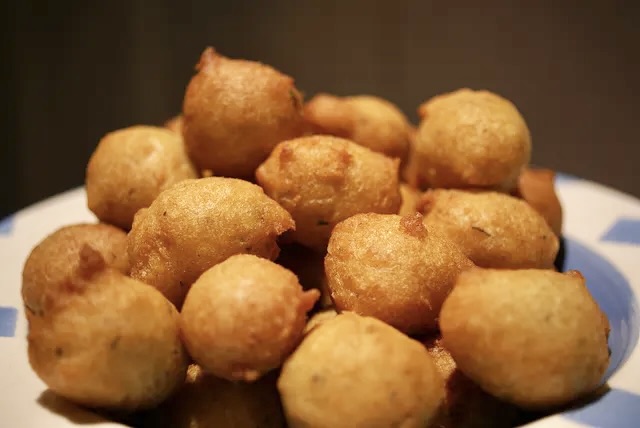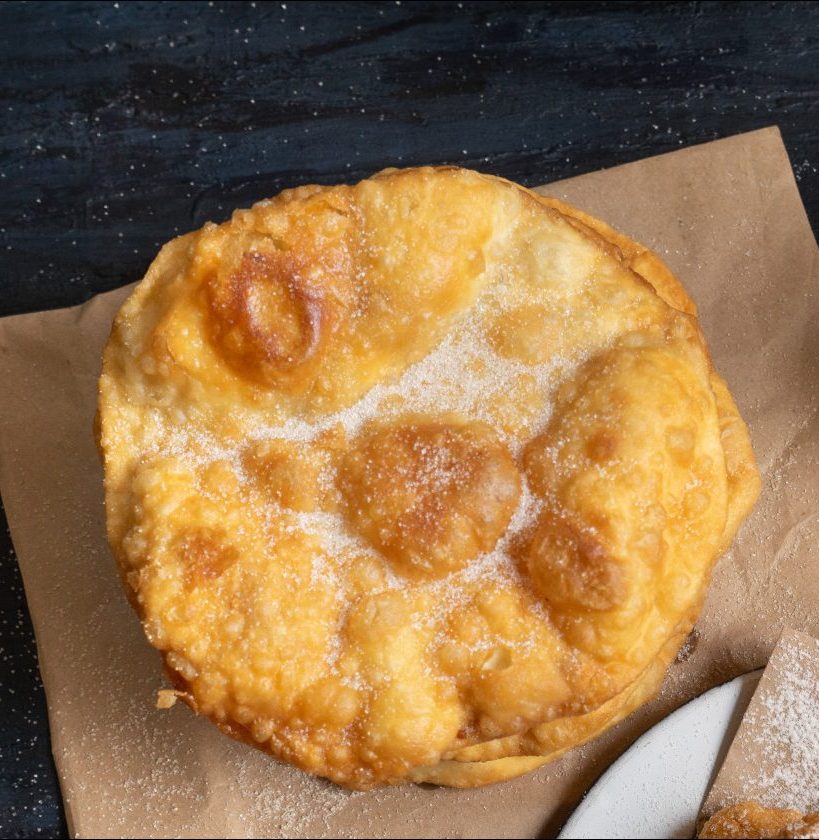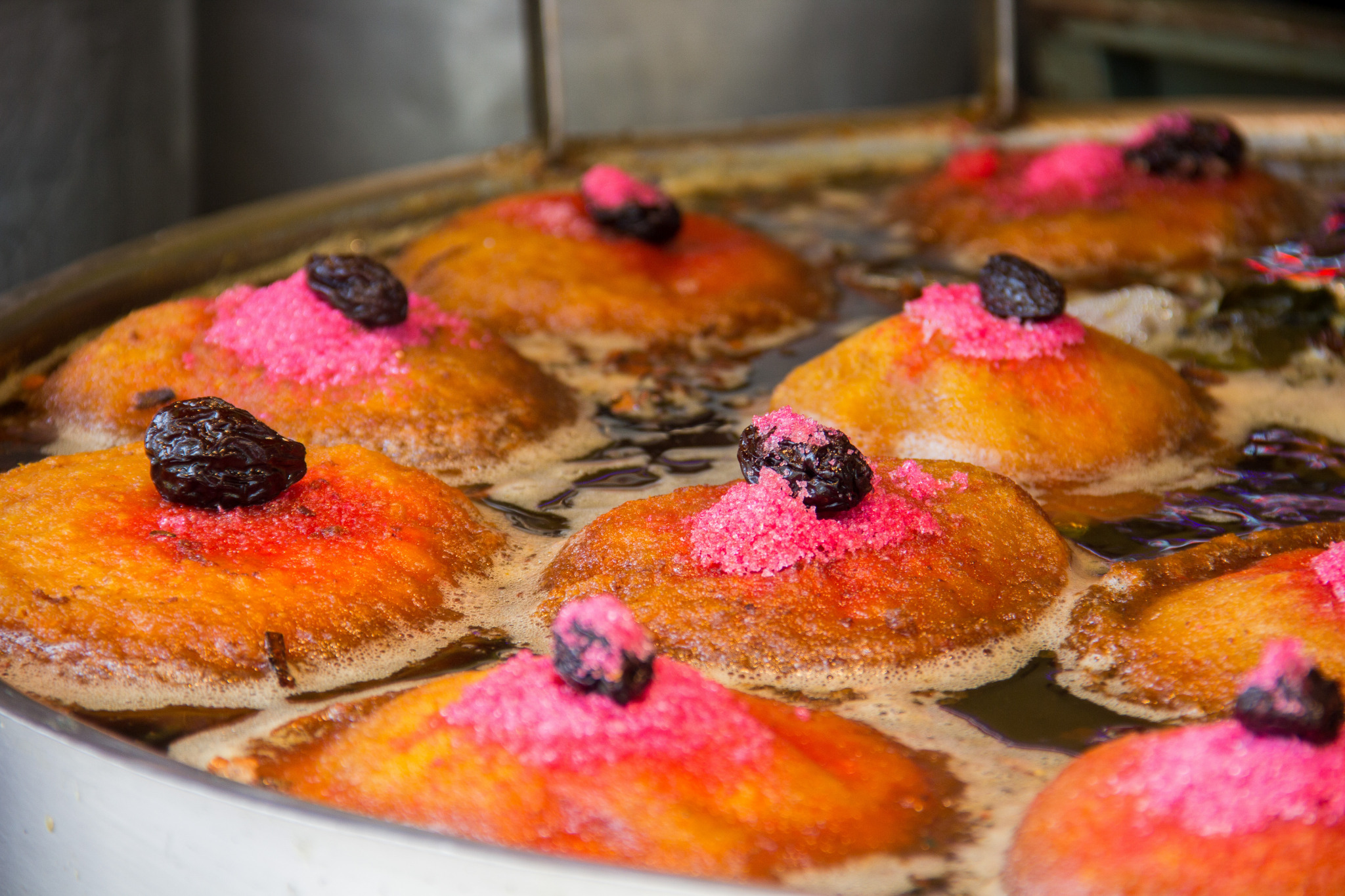This post is also available in: Español
Buñuelos Guatemaltecos are the quintessential Guatemalan comfort food for cold weather. They are a traditional Guatemalan dessert served for numerous occasions, from Christmas to baptisms and birthdays. A fritter-like ball of dough soaked in rich syrup, buñuelos dulces (or bunuelos) is a popular Guatemalan food commonly sold by street vendors, at state fairs, and during the holidays. But with my step-by-step instructions, you can now eat a bowl of delicious Guatemalan buñuelos any time of the year!

Buñuelos Dulces: A Mouthwatering Guatemalan Dessert
Growing up in Guatemala, buñuelos were always one of my favorite foods. I can still remember the sweet smell of the anise syrup floating in the air every time we went to a “feria.” It is one of my all-time favorite Guatemalan desserts, with its fluffy dough bathed in silky syrup.

My Nana made them at home, so I was lucky I didn’t have to wait for a special day to enjoy them. I remember spending hours in the kitchen with her, learning how to whisk “correctly” and making buñuelos from scratch. And at the start of school vacations, I would run to her house to start whipping the best traditional Guatemalan dishes, from savory tamales to sweet buñuelos and all in between.
Buñuelos Guatemaltecos is a very popular dish during December and cold-weather season since they are fried dough balls served in hot syrup. It is one of the best comfort food desserts from Guatemala. It is a dessert that always warms up my tummy and heart, and it’s perfect for enjoying during winter.
The History of Buñuelos
Buñuelos were brought to America by the Spanish. But according to Oaxacan historian Ruben Vasconcelos, the buñuelos actually reflect the Arab heritage of the settlers in the Iberian Peninsula. Throughout Latin America, you will find different versions of buñuelos. And although they may vary from one region to the next, they all have one thing in common: a wheat-based dough.

They can be round, flat, or even a twisted strip of dough. In Colombia, they make the dough with white cheese curd. In Mexico, they add brown sugar, guava, and cinnamon syrup, while in Nicaragua, they add yucca to the dough. And in Guatemala, the buñuelos are covered in white sugar and served bathed in light syrup with a hint of anise.
What is Buñuelos?
Buñuelos or bunuelos are balls of fried wheat-based dough, crisp on the outside and soft on the inside. The dough is commonly flavored with anise seeds and fried in hot oil, akin to doughnuts. They can be savory or sweet and come in different shapes and sizes. Guatemala’s version of buñuelos is a round ball of dough, fried, then bathed in a golden syrup made from brown sugar and anise.
The Guatemalans believe that this traditional Guatemalan dessert symbolizes good luck. Therefore, eating buñuelos during the holiday season will bring good fortune in the coming year. Eating buñuelos for good luck is a great excuse to indulge in this delicious dessert. What is so bad about trusting your luck on a decadent dessert? I say, scoop me a bowl… and maybe a second, to be on the safe side!
How Do You Say Buñuelos in English?
You might have heard Spanish words with the letter “Ñ,” like jalapeño and piñata. The sound is like a blended sequence of “n” and “y,” even though the letter Ñ is a whole consonant with its own sound in Spanish. So here is what Dictionary.com has to say about it (pun intended)
bu·ñu·e·los
[ boon-yoo-ey-loh; Spanish boo-nywe-law]
Guatemalan Buñuelos vs. Mexican Buñuelos
Even though they sound so much alike, Guatemalan buñuelos and Mexican buñuelos are different desserts. Both dishes are typical during the Christmas season and New Year. Buñuelos Guatemaltecos are crispy dough balls on the outside while fluffy on the inside. They are served hot in a rich caramel-like syrup with a hint of anise in a deep bowl.

On the other hand, Mexican buñuelos are fried fritters, crunchy and airy, shaped like tostadas. Mexican buñuelos de viento are light and airy and more similar to Guatemalan buñuelos but usually made with a rosette mold. They are typically flattened into a tortilla shape, fried, and then sprinkled with sugar and cinnamon. Most Mexicans also bathe their buñuelos a little in a heavy piloncillo syrup, but not as much as Guatemalans with our buñuelos swimming in it! For sure, both traditional desserts will have you asking for seconds!

What Are Buñuelos Made From?
Buñuelos are made from wheat flour-based dough combined with lard or shortening, eggs, and anise. First, you make small balls and fry them until you get a doughnut-like fritter. The cherry on top of this delicious Guatemalan dessert is the golden syrup made from brown sugar, water, and anise seeds. Then you “dunk” your buñuelos for the perfect balance of puffy batter and sweet taste.
How to Make the Best Guatemalan Buñuelos:
For the Syrup:
- 3 cups of water
- 1 ½ cups of brown sugar, packed
- 1 ½ teaspoon of anise seeds
For the Dough:
- ¾ cup all-purpose flour, sifted
- 1 teaspoon of baking powder
- ¼ teaspoon of salt
- 1 cup of water
- ½ teaspoon of anise seeds
- 3 tablespoons of lard or vegetable shortening
- 2 large eggs
- Peanut or vegetable oil (for frying)
Make the Syrup
- Combine the water, brown sugar, and anise seeds in a medium saucepan. Over medium heat, stir the mixture until the sugar has dissolved.
- Increase the heat and bring the liquid to a boil. Regulate the heat so that the mixture is simmering.
- Cook for about 20 minutes until it has reduced to about 1 ¼ cups. Set the syrup aside to cool.
Preparing the Dough
- Stir together flour, baking powder, and salt. Set aside.
- In a medium saucepan, combine the water, anise seeds, and lard and bring to a boil over medium-high heat.
- When the lard or shortening has melted and is boiling, remove it from heat. Stir in the flour mixture all at once. Return to the heat and continue stirring for a minute or two. The dough will be ready when it pulls away from the sides of the pan.
- Remove the saucepan from the heat for the last time and add the eggs, beating well after each addition. The dough should be very soft and only just hold its shape.
Time to Fry
- In a large, heavy skillet, heat about ½ inch of oil until it is smoking. Flour your hands well and break off a piece of dough. Roll it into a ball about the size of a golf ball.
- Carefully slip them into the oil. Be sure not to crowd the skillet (cook separate batches, if necessary).
- Drain the fried balls on paper towels. Then, sprinkle white or confectioner’s sugar over them.
- Serve warm, and drizzle the syrup over them.
Tips for making Buñuelos Dulces Guatemaltecos:
- Don’t over-knead or pound the dough too much. You want a soft dough that you can also shape easily. For a faster process, I like using a cookie scoop for even-sized buñuelos. But if you don’t have one, don’t worry; you can use your hands to make golf-size balls, about 1 inch each. Again, remember to flour your hands, so the dough doesn’t stick to your fingers too much.
- The temperature must be just right. At the start of the frying process, the oil must be hot. When you put a couple of buñuelos in, the temperature usually goes down. But if you see that it is too high, lower it so the dough has a golden crust outside and is cooked inside.
- Don’t stop now! Once you start making the buñuelos, I strongly recommend you don’t stop. It is best not to let the dough sit too long before frying, as it could dry up and change the consistency of the balls.

Make Ahead of Time
Although this is a straightforward recipe, you can make the dough a couple of days before to save prep time. Let the dough cool down, wrap it in plastic wrap, and store it in your fridge for up to 3 days. When ready to cook, take out the dough and shape the buñuelos into golf-size balls. You are good to continue with the frying and soaking part.
You can also make the syrup ahead and keep it chilled for one week in your refrigerator. Then, same as with the dough, let the syrup completely cool on your kitchen counter and then store it in an air-tight container. Then, when it is time to serve, you can either heat it in a saucepan or throw it in the microwave for a couple of minutes. Finally, serve buñuelos in a deep bowl with a scoop of syrup.
Can You Freeze Buñuelos?
I would not recommend freezing buñuelos. It’s best to make this Guatemalan dessert just before eating it and serve it fresh. However, you can store the bunuelos in the refrigerator for a couple of days once cooked. Just keep the dough balls and the syrup separately.
To reheat, leave the buñuelos out until they are at room temperature or pop them in the oven at 300°F for a couple of minutes. Then, heat the syrup and serve drizzled with the hot syrup. However, in my opinion, buñuelos are best when eaten right out of the frying pan. And I discovered that covering them with a napkin helps them last on your kitchen countertop for 2-3 days.
What To Serve with Traditional Guatemalan Buñuelos?
Buñuelos are the perfect dessert to follow your favorite Guatemalan foods, from tamales colorados to chiles rellenos or pepian de pollo! This Guatemalan dessert is best served hot and in a deep dish. I love to accompany it with a steaming cup of Guatemalan atol de elote or hot chocolate, perfect for those cold winter months.

I love serving these delicious fritters as snacks for my kids during Christmas while sipping a steaming cup of ponche de frutas navideño (hot fruit punch). We love to sit by the Christmas tree and reminisce about my childhood in Guatemala. Spending time with my family while sharing traditional Guatemalan food is vital for keeping our Hispanic heritage alive during the holiday season.
Guatemalan Buñuelos are the ultimate comfort food dessert! The perfect balance between crispy and sweet, this delicious Guatemalan dessert is ideal for the holiday season, a cold day, or any occasion. Once you try the crunchy dough with the richness of the syrup, you will know why buñuelos dulces are one of my favorite Guatemalan foods!
More Traditional Guatemalan Desserts You Must Try
Have you ever tried Guatemalan cuisine? It’s a delightful combination of Mayan and Spanish flavors, resulting in a one-of-a-kind taste experience. From rich torrejas to the unique blend of rellenitos, your taste buds are in for a real treat. Trust me, once you try it, you won’t be able to resist whipping up some of these recipes at home. So, let’s get our aprons on and get cooking!
Torrejas:
Often referred to as the Guatemalan French toasts, the torrejas are sweet bread soaked in a milk or eggs mixture before being fried in oil. Then, you usually bathe them in a sweet syrup made from boiling water and spices.

Canillitas de Leche:
Try a quick and easy recipe for canillitas, a delicious 10-minute dessert that uses only three ingredients you already have in your pantry.

Jocotes en Miel:
These juicy jocotes (hog plums) are cooked in a bubbling sweet syrup and heavenly spices.

Champurradas:
A super easy recipe that will surely be a total success with everyone in the family! A scrumptious giant cookie with the perfect level of crunch to dunk in your morning coffee!

Rellenitos de Plátano:
Tasty ripe plantains filled with beans covered in sugar. Although the combination might seem strange, this sweet plantain recipe is one of the most delicious Guatemalan foods.

Barquillos:
Indulge in the crispy delight of Guatemalan barquillos – delicate rolled wafer cookies with a sweet Latino flair. Whether paired with ice cream or enjoyed on their own, these treats are a must-try for any foodie looking to explore the diverse world of Guatemalan food.

Guatemalan Horchata:
Although technically not a dessert, this refreshing rice drink from Guatemala is a total game-changer! With its creamy blend of rice, cinnamon, and vanilla, this traditional Guatemalan beverage is the perfect treat on a hot day. But it is also a light dessert or snack your kids will love. So, kick back, relax, and get ready to sip your way to paradise with every delicious drop!

Plátanos En Mole
Indulge in the rich and velvety flavors of Platanos en Mole, a sweet and savory Guatemalan dessert that will tantalize your taste buds. Featuring tender ripe plantains coated in a rich chocolate mole sauce, this traditional dish is perfect for any occasion.

Empanadas De Manjar De Leche (Filled With Custard)
Whether you’re looking for a sweet treat to enjoy with your morning coffee or a satisfying dessert to finish off your meal, these empanadas are sure to hit the spot. These delicious hand pies feature a flaky crust, and creamy custard filling will satisfy your sweet cravings!


Guatemalan Buñuelos
Fried dough balls bathed in a rich, sweet syrup, this Guatemalan dessert is perfect for cold weather.
Ingredients
For the Syrup:
- 3 cups of water
- 1 ½ cups of brown sugar, packed
- 1 ½ teaspoon of anise seeds
For the Dough:
- ¾ cup all-purpose flour, sifted
- 1 teaspoon of baking powder
- ¼ teaspoon of salt
- 1 cup of water
- ½ teaspoon of anise seeds
- 3 tablespoons of lard or vegetable shortening
- 2 large eggs
- 1 cup (or more) peanut or vegetable oil (for frying)
Instructions
Make the syrup
- Combine the water, brown sugar, and anise seeds in a medium saucepan. Over medium heat, stir the mixture until the sugar has dissolved.
- Increase the heat and bring the liquid to a boil. Regulate the heat so that the mixture is simmering.
- Cook for about 20 minutes until it has reduced to about 1 ¼ cups. Set the syrup aside to cool.
Preparing the dough
- Stir together flour, baking powder, and salt. Set aside.
- In a medium saucepan, combine the water, anise seeds, and lard and bring to a boil over medium-high heat.
- When the lard has melted, and the liquid is boiling, remove from the heat and stir in the flour mixture all at once. Return to the heat and continue stirring for a minute or two. The dough will be ready when it pulls away from the sides of the pan.
- Remove the saucepan from the heat for the last time and add the eggs, beating well after each addition. The dough should be very soft and only just hold its shape.
Time to Fry:
- In a large, heavy skillet, heat about ½ inch of oil until it is smoking. Flour your hands well and break off a piece of dough. Roll it into a ball about the size of a golf ball. You can also use a cookie scoop to shape the balls.
- Carefully slip them into the oil. Be sure not to crowd the skillet (cook separate batches, if necessary). If the oil is too hot, lower it a little to give time for the buñuelo to cook all the way through.
- Drain the fried balls on paper towels until you have finished cooking all of them. Then, sprinkle white or confectioner’s sugar over them.
- Serve warm and drizzle the syrup over them.
Notes
Once you start making the buñuelos, I strongly recommend you don't stop. It is best not to let the dough sit too long before frying, as it could dry up and change the consistency of the balls.
Nutrition Information:
Yield: 12 Serving Size: 1 buñueloAmount Per Serving: Calories: 300Total Fat: 22.3gSaturated Fat: 5.1gCholesterol: 34mgSodium: 70mgCarbohydrates: 24.2gFiber: 0.3gSugar: 17.7gProtein: 2g
This recipe uses estimated serving sizes based on a 2,000-calorie-a-day diet. Values may vary depending on ingredients, brands, serving packages, or other nutritional factors.
Compensated affiliate links are used in this post. In addition, as an Amazon Associate and member of other affiliate programs, I earn from qualifying purchases.



me gustaria si puedes poner esta receta en espanol pofavor gracias
Gracias Paula, estaba buscando la receta en Inglés para compartirla con compañeros de trabajo que no hablan español. Es perfecta.
Que bueno que te sirvio. 🙂 Saludso desde FL.
Paula, gracias por la receta, mi hijo está en 3er grado y esta semana tenían que hacer un reporte del país de descendencia, hoy todos los niños llevaron un plato típico y receta del país correspondiente, mi hijo llevo buñuelos 🙂 tu receta. A los niños les gustaron mucho, cuando regresamos de la escuela mi hijo me pidió que hiciera MAS!
GRACIAS!
Ximena
California
this is a great receipe. I will be trying it for the first time. I am Guatemalan but I do not know how to make any of the dishes from my country. when we came to America I was too young and I am glad I am now finding these. wish me luck and I look forward to more receipies.
How many bunuelos does this make?